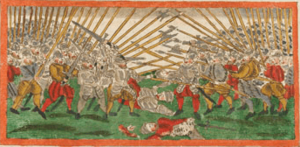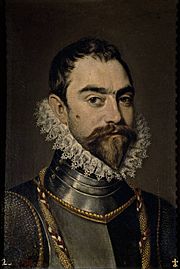Battle of Zutphen facts for kids
Quick facts for kids Battle of Zutphen |
|||||||
|---|---|---|---|---|---|---|---|
| Part of the Eighty Years' War | |||||||
 Picture by Johann Jakob Wick illustrating his report about the Battle of Zutphen, published on 12 October 1586 |
|||||||
|
|||||||
| Belligerents | |||||||
| Commanders and leaders | |||||||
| Casualties and losses | |||||||
| 12 cavalry and 22 foot soldiers killed | ~200 soldiers killed | ||||||
The Battle of Zutphen was a fight that happened on September 22, 1586. It took place near the town of Zutphen in the Netherlands. This battle was part of the Eighty Years' War, a long conflict where the United Provinces of the Netherlands fought for their independence from Spain.
In 1585, England decided to help the Dutch rebels. Queen Elizabeth I of England signed a special agreement called the Treaty of Nonsuch. This meant England officially joined the war against Spain. Robert Dudley, a powerful English leader, was sent to the Netherlands. He became the Governor-General and led an English army to support the Dutch.
Contents
What was the Battle of Zutphen?
The Battle of Zutphen happened when the Spanish army, led by Alessandro Farnese, Duke of Parma, was trying to take the town of Rheinberg. In response, the English and Dutch forces, under the Earl of Leicester, started to surround the town of Zutphen. Zutphen was very important to the Spanish because it allowed them to collect money and supplies from the rich Veluwe area.
The Spanish commander, Farnese, knew he had to help Zutphen. He sent supplies to the town himself at first. But as the English and Dutch continued their siege, he put together a large group of wagons filled with food and other goods. He trusted Alfonso Félix de Ávalos Aquino y Gonzaga, Marquis del Vasto to deliver this important convoy safely to Zutphen.
How the Battle Began
The English found out about the Spanish convoy when they captured a messenger. This messenger was carrying a letter from Farnese to Francisco Verdugo, the Spanish leader in Zutphen. Learning about the convoy, the English and Dutch decided to set up a surprise attack, also known as an ambush. Many English knights and noblemen were part of this plan.
The English army, led by the Earl of Leicester, set up their ambush near a small village called Warnsveld. This village was only half a mile from Zutphen. The English forces included famous leaders like the Earl of Essex, Sir John Norreys, Sir William Stanley, and Lord Willoughby. Leicester's nephew, the poet and courtier Sir Philip Sidney, was also there.
The morning of September 22 was very misty. This meant the English met the Spanish convoy sooner than they expected. The Spanish cavalry rode at the front, followed by foot soldiers and wagons. Other soldiers walked beside the wagons to protect them.
The Fight Begins
Around 8:00 AM, the Spanish convoy, led by the Marquis del Vasto, passed Warnsveld. Sir William Stanley and Lord Audley, leading the English advanced soldiers, started to fight the Spanish front line.
The Earl of Essex then charged forward with the English cavalry. He shouted, "Follow me, good fellows, for the honour of England and of England's Queen!" At first, the English charge pushed back the Spanish front. However, the Spanish foot soldiers, who carried long spears called pikes, quickly formed a strong defense. They kept the path open for the wagons.
The people driving the wagons ran away when the fighting started. So, Spanish soldiers had to take their places and move the wagons towards Zutphen. The English soldiers tried to break through the Spanish lines, but the Spanish held their ground. The English cavalry charged two more times, but they could not get past the strong Spanish defense.
To help his foot soldiers, the Marquis del Vasto gathered his cavalry and attacked the English. He was almost killed but was saved by one of his soldiers. Meanwhile, Francisco Verdugo, who was in Zutphen, heard the sounds of battle. He quickly rode out with more Spanish troops to join the fight.
During the battle, the Spanish cavalry that had been left behind by Del Vasto also arrived. Some of these cavalry leaders, like Count Hannibal Gonzaga and Captain George Crescia, bravely attacked the English on their own. Crescia was captured, and Gonzaga was badly hurt.
On the English side, Sir Philip Sidney, a well-known leader, was seriously wounded in the leg during the last charge. The Spanish cavalry then moved behind their foot soldiers for protection. Verdugo and Del Vasto managed to get their troops organized again. Seeing how well the Spanish were fighting, the English and Dutch leaders decided not to continue the attack. They began to retreat back to their camp.
What Happened After the Battle?
The Battle of Zutphen was a Spanish victory. They successfully delivered the supplies to the town. People at the time often described a tough fight as "as warm as the fight of Zutphen."
A Sad Loss: Philip Sidney
The battle is especially remembered because of the death of Sir Philip Sidney. He was a famous poet and a brave soldier. He was wounded in the leg during the battle and was taken to the town of Arnhem to recover. Sadly, he died three weeks later from the injury because doctors could not remove the bullet.
Historians are not sure about the exact number of soldiers lost on each side. Some say about 13 English cavalry and 22 English foot soldiers were killed, while around 200 Spanish soldiers died. Others say the Spanish won with very few losses.
Spanish Gains and English Losses
Even after the battle, the Earl of Leicester continued to try and take Zutphen. He did not succeed in capturing the town itself. However, he did manage to take some important forts nearby, including Zutphen's "sconce" (a small fort) on the other side of the IJssel river. This sconce was captured by surprise by Edward Stanley and 12 other soldiers.
After this, both the English and Dutch armies settled into their winter camps. Some English leaders were put in charge of important places. Sir William Stanley was given command of Deventer, and Rowland York was put in charge of Zutphen's sconce. However, these choices caused some worry among the Dutch.
In 1587, both Stanley and York switched sides and joined the Spanish. They handed over Deventer and Zutphen's sconce to the Spanish army. This act undid the gains made by the English in 1586. It also made the Dutch lose trust in the English troops. Because of these losses, the Spanish were able to collect money and supplies from more areas in the Netherlands. Zutphen and Deventer remained under Spanish control until they were finally captured by Maurice of Nassau in 1591.
See also
 In Spanish: Batalla de Zutphen (1586) para niños
In Spanish: Batalla de Zutphen (1586) para niños






